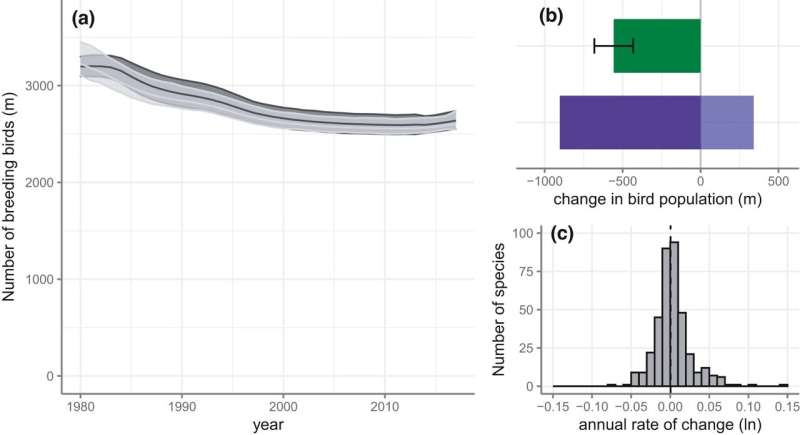November 17, 2021 report
Survey shows huge bird population drop in Europe and the UK over past 40 years

A team of researchers affiliated with multiple institutions in the U.K. and one in the Czech Republic has found huge losses in bird numbers in the U.K. and Europe over the past 40 years. In their paper published in the journal Ecology and Evolution, the group describes their analysis of database data on bird survey numbers across Europe and the U.K.
Two years ago, a team of researchers in the U.S. and Canada found that the population of birds in North America was approximately three billion less today than in the 1970s—marking not just a reduction in bird numbers but a reduction in bird diversity. In this new effort, the researchers took a similar look at bird numbers in Europe and the U.K. using bird census data going back to the 1980s.
The researchers found that like North America, Europe and the U.K have seen huge bird population drops in general. Overall they found there were approximately 600 million fewer birds today than there were forty years ago. They also found that some species have been hit harder than others. There were 247 million fewer house sparrows in Europe, for example (halving their population), while there were 97 million fewer yellow wagtails, 75 million fewer starlings and 68 million fewer skylarks.
It is not known why there are fewer birds but most in the field suspect that the shrinking numbers are due to human encroachment, the abundance of house cats, loss of food resources due to insecticide use and the introduction of harmful elements into the environment, such as pollution.
The data showed that losses have occurred across virtually all varieties of birds, including both long distance migraters and shorebirds. But it also showed that not all species saw decreases and in fact some saw increases, including chiffchaff, blackcap, blackbird, goldfinch, wren, woodpigeon, blue tit and robin. And some, such as the peregrine falcon, have seen their populations double. Most such increases were due to conservation and protection efforts, they claim.
They conclude by noting that as with birds in North America, the decline in so many populations represents a blow against bird diversity in Europe and the U.K. Common birds, they note are becoming less and less common—and if something is not done, hundreds of species could disappear completely.
More information: Fiona Burns et al, Abundance decline in the avifauna of the European Union reveals cross‐continental similarities in biodiversity change, Ecology and Evolution (2021).
Journal information: Ecology and Evolution
© 2021 Science X Network





















